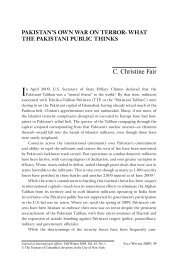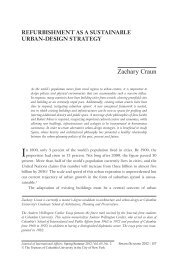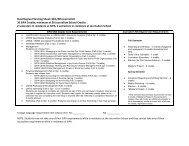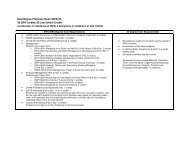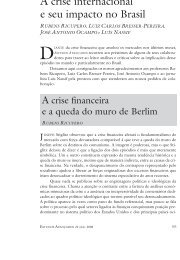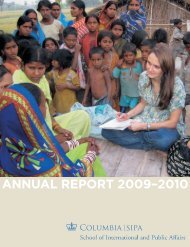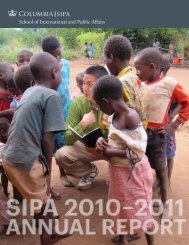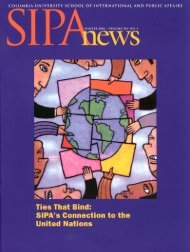high levels of unemployment <strong>and</strong> poverty, just as IDP communities do. 335 However, these issues hitvulnerable groups like IDPs most acutely. 336 While there is sympathy across <strong>Georgia</strong>n society for theplight if IDPs, it does not necessarily translate <strong>in</strong>to susta<strong>in</strong>ed support. Experts argue that IDPs should beperceived as a resource rather than just “passive receivers of assistance.” 337 It seems that IDPs have akey role to play <strong>in</strong> the effort to shift this perception.The NGO community has approached IDPs <strong>in</strong> order to help transform passivity <strong>in</strong>to mobilization. TasoFoundation Director Mar<strong>in</strong>a Tabukashvili discusses her organization’s <strong>in</strong>itiatives to engage IDPs by firstexp<strong>and</strong><strong>in</strong>g their “underst<strong>and</strong><strong>in</strong>g of the importance of participation.” 338 Experts note that this populationis primarily mobilized around issues directly concern<strong>in</strong>g IDPs, such as hous<strong>in</strong>g <strong>and</strong> social assistance.Rather than actively engag<strong>in</strong>g on other political issues, “as a group, [IDPs] are not seen as participat<strong>in</strong>g<strong>in</strong> usual political life.” 339 Organizations such as Taso therefore work to promote IDPs’ participation atvarious levels, from community development projects to national policies.Some extreme examples of IDPs protest<strong>in</strong>g their situation also do exist, counter<strong>in</strong>g the image of them aspassive members of society. In a case of self-immolation, an IDP woman named N<strong>in</strong>a Pipia protested thegovernment’s neglect of IDPs. 340 Paata Davitaia of the parliamentary party ‘European Democrats’(formerly the ‘On Our Own’ Party) described this situation: “The woman…went to the m<strong>in</strong>istry to <strong>in</strong>quireabout accommodation...The [MRA] Deputy M<strong>in</strong>ister told...[her] to eat grass, <strong>and</strong> the woman burnedherself <strong>in</strong> front of the m<strong>in</strong>istry. “ 341 A gender researcher noted that “it was like a suicide for her.” Shealso commented on the lack of mobility follow<strong>in</strong>g Ms. Pipia’s death: “I can’t see many IDP womenactive…Maybe there are s<strong>in</strong>gly persons who are do<strong>in</strong>g someth<strong>in</strong>g, but not so many. But this is aproblem not only with IDPs, but <strong>in</strong> <strong>Georgia</strong> generally.” 342 This example serves as perhaps the mostradical case counter<strong>in</strong>g the idea that IDPs are passive. Moreover, it highlights that <strong>Georgia</strong>n society <strong>in</strong>general seems to lack significant engagement <strong>in</strong> political life. The failure here to <strong>in</strong>spire the IDPcommunity <strong>and</strong> broader society to mobilize <strong>and</strong> achieve tangible changes could promote further lack offaith <strong>in</strong> the efficacy of political protest, thereby encourag<strong>in</strong>g passivity.IDP Identity <strong>and</strong> StatusIdentity serves as a fundamental psychosocial factor <strong>in</strong>fluenc<strong>in</strong>g IDP participation. The experience ofdisplacement is often one that <strong>in</strong>delibly impacts a person’s view of his- or herself <strong>and</strong> relationship todifferent communities <strong>in</strong> post-displacement life. IDP identity may connect with pa<strong>in</strong>ful memories of loss<strong>and</strong> displacement. Life <strong>in</strong> displacement also imbues a status that <strong>in</strong>fluences IDPs’ day-to-day needs, <strong>in</strong>335 Maria Guledani, Personal Interview.336 Ombudsman Representative, Personal Interview, 15 March 2012.337 Manana Gabashvili, Personal Interview.338 Mar<strong>in</strong>a Tabukashvili, Personal Interview.339 Nana Sumbadze, Personal Interview.340 Radio Free Europe-Radio Liberty, “Self-Immolation Incident Highlights Desperation of <strong>Georgia</strong>n IDPs,” 29 Oct 2012, accessed7 May 2012, 341 Paata Davitaia, Personal Interview.342 Gender researcher, Personal Interview, 21 March 2012.65
addition to their longer-term rights. It <strong>in</strong>volves some privileges, such as access to a small monthlystipend, hous<strong>in</strong>g support, <strong>and</strong> social services. IDP identity is also directly tied to the right to return -many IDPs hold on to their status because it symbolizes their claim to their property left beh<strong>in</strong>d <strong>in</strong>Abkhazia <strong>and</strong> South Ossetia. This approach has arguably deterred the <strong>in</strong>tegration process for some IDPs,an attitude that the government has <strong>in</strong> many ways also supported. The politicization of this group’sidentity over the past two decades has proved a challenge for the group as a whole to escape the<strong>in</strong>herent association with political <strong>in</strong>terests around the conflict.These various <strong>in</strong>dividual <strong>and</strong> collective issues make identification with IDP status a complicated concern.The extent to which IDPs identify with this term is unique to each person. Some IDPs speak collectivelyabout IDP <strong>in</strong>terests, while others prefer to speak about <strong>in</strong>dividual needs. This is a choice that eachdisplaced person has the right to make based on his or her own needs <strong>and</strong> <strong>in</strong>terests. These choicesdirectly <strong>in</strong>fluence the extent to which IDPs feel <strong>and</strong> promote solidarity as a group.The decision to underst<strong>and</strong> IDP identity as a personal characteristic versus a label for a group hassignificant political implications related to IDPs’ <strong>in</strong>tegration <strong>and</strong> participation <strong>in</strong> society. On the oneh<strong>and</strong>, some IDP advocates make the argument that members of this population should rally beh<strong>in</strong>d thisidentity <strong>in</strong> order to build a more significant lobby<strong>in</strong>g group that can promote IDPs’ particular needs <strong>and</strong><strong>in</strong>terests. Others question whether identify<strong>in</strong>g IDPs as a separate group <strong>in</strong> fact h<strong>in</strong>ders their <strong>in</strong>tegrationprocess, as it re<strong>in</strong>forces their dist<strong>in</strong>ction from the broader population. While it is clear that displacedpersons’ opportunities for participation are lack<strong>in</strong>g, efforts to remedy the issue must address this keyquestion. Only <strong>in</strong> this way can they support IDPs <strong>in</strong> participat<strong>in</strong>g as they see fit: as <strong>in</strong>dividual members ofsociety or as members of an IDP constituency.The fact that it is impossible to speak about one IDP identity further challenges efforts to rally beh<strong>in</strong>d aunify<strong>in</strong>g concept of what it means to belong to this group. IDP identity is fragmented by gender, by twodifferent waves of displacement, <strong>and</strong> by liv<strong>in</strong>g situation, <strong>and</strong> these fragmentations all contribute topsychosocial divisions with<strong>in</strong> IDP communities. By <strong>and</strong> large, IDP identity <strong>in</strong> <strong>Georgia</strong> seems to connectmore to <strong>in</strong>dividual <strong>and</strong> family conditions rather than a sense of collective solidarity. This <strong>in</strong>fluences thechoices that IDPs make <strong>in</strong> participat<strong>in</strong>g with<strong>in</strong> their communities or though broader coalitions tostrengthen their voices on local <strong>and</strong> national levels.IDPs’ strong social networks imply that there is at least some sense of unity with<strong>in</strong> IDP communities.One IDP noted the untapped strength of IDP networks: “Generally people liv<strong>in</strong>g <strong>in</strong> collective centershave been a community for many years, so there’s very strong social network connections among thoseIDPs, <strong>and</strong> then they might have a family connection with a community <strong>in</strong> another collective center notfar away. 343 ” Such networks have led to the creation of unique <strong>in</strong>itiatives. IDP solidarity has beencapitalized, for <strong>in</strong>stance, through local <strong>in</strong>itiatives like the Taso Foundation’s self-help groups. These343 T<strong>in</strong>a Gewis, Personal Interview.66
- Page 2 and 3:
Promoting IDPs’ and Women’s Voi
- Page 4 and 5:
CONTENTSAcronyms and Abbreviations
- Page 6 and 7:
EXECUTIVE SUMMARYInternally displac
- Page 8 and 9:
THE WOMEN’S POLITICAL RESOURCE CE
- Page 10 and 11:
fair reporting on politically sensi
- Page 12 and 13:
people-to-people diplomacy efforts
- Page 14 and 15:
and the Guiding Principles, in Febr
- Page 16 and 17: an effort to address these stereoty
- Page 18 and 19: The identities, perceptions, and re
- Page 20 and 21: even IDPs themselves. The HRBA seek
- Page 22 and 23: Karaleti settlement, and Potskho-Et
- Page 24 and 25: displacement differently, with men
- Page 26 and 27: on an equal footing with men in for
- Page 28 and 29: The Ministry for Internally Displac
- Page 30 and 31: Defender’s Office) and leave no r
- Page 32 and 33: prominent national level IDP NGO wo
- Page 34 and 35: in the past but none have yet to be
- Page 36 and 37: Grassroots Peacebuilding EffortsCiv
- Page 38 and 39: esettlement and local integration h
- Page 40 and 41: ability to contribute to the new Ac
- Page 42 and 43: Women convened a working group to a
- Page 44 and 45: were involved, in addition to “wo
- Page 46 and 47: towards addressing this population
- Page 48 and 49: waves. 224 A Conciliation Resources
- Page 50 and 51: governing shelter requirements. 238
- Page 52 and 53: esults of eviction on those who did
- Page 54 and 55: FINDINGSSIPA team member Drilon Gas
- Page 56 and 57: unique opportunities exist for them
- Page 58 and 59: an important opportunity for women
- Page 60 and 61: early morning…when I was going to
- Page 62 and 63: our office to investigate these iss
- Page 64 and 65: on this? It’s impossible.” 322
- Page 68 and 69: groups do not differentiate between
- Page 70 and 71: funding and influence to implement
- Page 72 and 73: een in operation for two years or l
- Page 74 and 75: organization, and highlighted that
- Page 76 and 77: The Education System’s Influence
- Page 78 and 79: system has an important role to pla
- Page 80 and 81: Political FactorsMany elements of t
- Page 82 and 83: international organizations working
- Page 84 and 85: uling party. 433 There were some si
- Page 86 and 87: especially highly-influential broad
- Page 88 and 89: ationale behind the government’s
- Page 90 and 91: international working for a major d
- Page 92 and 93: Also, according to a World Bank rep
- Page 94 and 95: willing to challenge authorities th
- Page 96 and 97: The lack of narrative connecting po
- Page 98 and 99: RECOMMENDATIONS FOR THE GEORGIAN GO
- Page 100 and 101: the government also needs to commit
- Page 102 and 103: ‣ Continue to support and expand
- Page 104 and 105: ‣ Address male IDP needs (Immedia
- Page 106 and 107: The campaign should have a face, su
- Page 108 and 109: APPENDIX BList of IntervieweesLocal
- Page 110 and 111: Kristy KellyLincoln MitchellLawrenc
- Page 112 and 113: Article 10 - Non-discrimination in
- Page 114 and 115: Principle 18.1 - Adequate standard
- Page 116 and 117:
Esaiashvili, Mariam (Official, Mini
- Page 118 and 119:
Lanskoy, Miriam and Giorgi Areshidz
- Page 120:
Transparency International Georgia.






